时间序列
日期和时间数据类型及工具
from datetime import datetime
now = datetime.now()
now
datetime.datetime(2022, 3, 4, 8, 23, 31, 842698)
now.year,now.month,now.day
(2022, 3, 4)
delta = datetime(2022,3,3)-datetime(1998,10,20,8,10)
delta
datetime.timedelta(days=8534, seconds=57000)
delta.days
8534
delta.seconds
57000
from datetime import timedelta
start = datetime(2022,3,3)
start + timedelta(12)
datetime.datetime(2022, 3, 15, 0, 0)
start - 2*timedelta(12)
datetime.datetime(2022, 2, 7, 0, 0)
import matplotlib.pyplot as plt
from pylab import *
img = plt.imread('datetime模块中的数据类型.png')
imshow(img)

字符串和datetime的相互转换
stamp = datetime.datetime(2022,3,3)
str(stamp)
'2022-03-03 00:00:00'
stamp.strftime('%Y-%m-%d')
'2022-03-03'
import matplotlib.pyplot as plt
from pylab import *
img = plt.imread('datetime格式定义.png')
imshow(img)
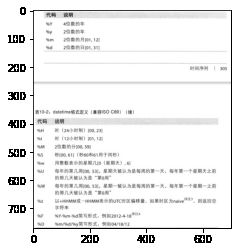
value = '2022-03-03'
datetime.datetime.strptime(value,'%Y-%m-%d')
datetime.datetime(2022, 3, 3, 0, 0)
datestrs = ['7/6/2022','8/6/2022']
[datetime.datetime.strptime(x,'%m/%d/%Y') for x in datestrs]
[datetime.datetime(2022, 7, 6, 0, 0), datetime.datetime(2022, 8, 6, 0, 0)]
from dateutil.parser import parse
parse('2022-03-03')
datetime.datetime(2022, 3, 3, 0, 0)
parse('Jan 31,1997 10:45 PM')
datetime.datetime(2022, 1, 31, 22, 45)
parse('6/12/2011',dayfirst=True)
datetime.datetime(2011, 12, 6, 0, 0)
import pandas as pd
pd.to_datetime(datestrs)
DatetimeIndex(['2022-07-06', '2022-08-06'], dtype='datetime64[ns]', freq=None)
idx = pd.to_datetime(datestrs + [None])
idx
DatetimeIndex(['2022-07-06', '2022-08-06', 'NaT'], dtype='datetime64[ns]', freq=None)
idx[2]
NaT
pd.isnull(idx)
array([False, False, True])
import matplotlib.pyplot as plt
from pylab import *
img = plt.imread('特定于当前环境的日期格式.png')
imshow(img)
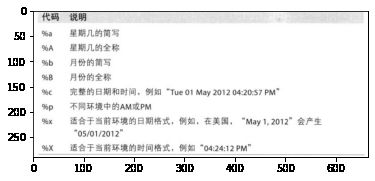
时间序列基础
from datetime import datetime
from pandas import DataFrame, Series
dates = [datetime(2011,1,2),datetime(2011,1,5),datetime(2011,1,7),
datetime(2011,1,8),datetime(2011,1,10),datetime(2011,1,12)]
ts = Series(np.random.randn(6),index=dates)
ts
2011-01-02 0.955968
2011-01-05 -3.053080
2011-01-07 -0.724017
2011-01-08 -1.219987
2011-01-10 -0.303126
2011-01-12 -0.979242
dtype: float64
type(ts)
pandas.core.series.Series
ts.index
DatetimeIndex(['2011-01-02', '2011-01-05', '2011-01-07', '2011-01-08',
'2011-01-10', '2011-01-12'],
dtype='datetime64[ns]', freq=None)
ts + ts[::2]
2011-01-02 1.911936
2011-01-05 NaN
2011-01-07 -1.448034
2011-01-08 NaN
2011-01-10 -0.606251
2011-01-12 NaN
dtype: float64
ts.index.dtype
dtype('
stamp = ts.index[0]
stamp
Timestamp('2011-01-02 00:00:00')
索引、选取、子集构造
stamp = ts.index[2]
ts[stamp]
-0.7240168825490924
ts['1/10/2011']
-0.30312563460424696
ts['20110110']
-0.30312563460424696
longer_ts = Series(np.random.randn(1000),
index=pd.date_range('1/1/2000',periods=1000))
longer_ts
2000-01-01 -0.238369
2000-01-02 1.119693
2000-01-03 0.092546
2000-01-04 1.110926
2000-01-05 0.170824
...
2002-09-22 -0.468025
2002-09-23 0.260535
2002-09-24 -1.058960
2002-09-25 0.485363
2002-09-26 -0.593321
Freq: D, Length: 1000, dtype: float64
longer_ts['2001']
2001-01-01 0.333511
2001-01-02 0.669764
2001-01-03 -1.459111
2001-01-04 0.316825
2001-01-05 -0.949078
...
2001-12-27 -1.992184
2001-12-28 0.062251
2001-12-29 0.750101
2001-12-30 -0.673639
2001-12-31 -1.512151
Freq: D, Length: 365, dtype: float64
longer_ts['2001-05']
2001-05-01 1.023397
2001-05-02 0.320480
2001-05-03 -0.518482
2001-05-04 -1.238117
2001-05-05 -0.295051
2001-05-06 1.482434
2001-05-07 0.034568
2001-05-08 -1.260276
2001-05-09 0.661322
2001-05-10 1.838568
2001-05-11 0.978017
2001-05-12 1.347121
2001-05-13 0.665021
2001-05-14 -2.233556
2001-05-15 -0.737499
2001-05-16 -0.596111
2001-05-17 1.853862
2001-05-18 -0.925573
2001-05-19 -1.398981
2001-05-20 -0.631674
2001-05-21 1.084205
2001-05-22 0.947516
2001-05-23 -0.022117
2001-05-24 -0.056961
2001-05-25 -0.477587
2001-05-26 0.097978
2001-05-27 1.341151
2001-05-28 -0.346732
2001-05-29 -1.079403
2001-05-30 1.244231
2001-05-31 1.772584
Freq: D, dtype: float64
ts[datetime(2011,1,7)]
-0.7240168825490924
ts
2011-01-02 0.955968
2011-01-05 -3.053080
2011-01-07 -0.724017
2011-01-08 -1.219987
2011-01-10 -0.303126
2011-01-12 -0.979242
dtype: float64
ts['1/6/2011':'1/11/2011']
2011-01-07 -0.724017
2011-01-08 -1.219987
2011-01-10 -0.303126
dtype: float64
ts.truncate(after='1/9/2011')
2011-01-02 0.955968
2011-01-05 -3.053080
2011-01-07 -0.724017
2011-01-08 -1.219987
dtype: float64
dates = pd.date_range('1/1/2000',periods=100,freq='W-WED')
long_df = DataFrame(np.random.randn(100,4),
index=dates,
columns=['Colorado','Texas','New York','Ohio'])
long_df.loc['5-2001']
|
Colorado |
Texas |
New York |
Ohio |
| 2001-05-02 |
-1.864282 |
0.085645 |
-1.803818 |
0.923839 |
| 2001-05-09 |
0.344391 |
0.471942 |
2.089121 |
-1.123721 |
| 2001-05-16 |
0.770508 |
0.618750 |
-0.787188 |
-1.083100 |
| 2001-05-23 |
0.743285 |
-0.468671 |
0.610547 |
0.957291 |
| 2001-05-30 |
0.343177 |
-1.018066 |
1.196951 |
-0.434751 |
带有重复索引的时间序列
dates = pd.DatetimeIndex(['1/1/2000','1/2/2000','1/2/2000','1/2/2000','1/3/2000'])
dup_ts = Series(np.arange(5),index=dates)
dup_ts
2000-01-01 0
2000-01-02 1
2000-01-02 2
2000-01-02 3
2000-01-03 4
dtype: int32
dup_ts.index.is_unique
False
dup_ts['1/3/2000']
4
dup_ts['1/2/2000']
2000-01-02 1
2000-01-02 2
2000-01-02 3
dtype: int32
grouped = dup_ts.groupby(level=0)
grouped.mean()
2000-01-01 0.0
2000-01-02 2.0
2000-01-03 4.0
dtype: float64
grouped.count()
2000-01-01 1
2000-01-02 3
2000-01-03 1
dtype: int64
日期的范围、频率以及移动
ts
2011-01-02 0.955968
2011-01-05 -3.053080
2011-01-07 -0.724017
2011-01-08 -1.219987
2011-01-10 -0.303126
2011-01-12 -0.979242
dtype: float64
ts.resample('D')
生成日期范围
index = pd.date_range('4/1/2012','6/1/2012')
index
DatetimeIndex(['2012-04-01', '2012-04-02', '2012-04-03', '2012-04-04',
'2012-04-05', '2012-04-06', '2012-04-07', '2012-04-08',
'2012-04-09', '2012-04-10', '2012-04-11', '2012-04-12',
'2012-04-13', '2012-04-14', '2012-04-15', '2012-04-16',
'2012-04-17', '2012-04-18', '2012-04-19', '2012-04-20',
'2012-04-21', '2012-04-22', '2012-04-23', '2012-04-24',
'2012-04-25', '2012-04-26', '2012-04-27', '2012-04-28',
'2012-04-29', '2012-04-30', '2012-05-01', '2012-05-02',
'2012-05-03', '2012-05-04', '2012-05-05', '2012-05-06',
'2012-05-07', '2012-05-08', '2012-05-09', '2012-05-10',
'2012-05-11', '2012-05-12', '2012-05-13', '2012-05-14',
'2012-05-15', '2012-05-16', '2012-05-17', '2012-05-18',
'2012-05-19', '2012-05-20', '2012-05-21', '2012-05-22',
'2012-05-23', '2012-05-24', '2012-05-25', '2012-05-26',
'2012-05-27', '2012-05-28', '2012-05-29', '2012-05-30',
'2012-05-31', '2012-06-01'],
dtype='datetime64[ns]', freq='D')
pd.date_range(start='4/1/2012',periods=20)
DatetimeIndex(['2012-04-01', '2012-04-02', '2012-04-03', '2012-04-04',
'2012-04-05', '2012-04-06', '2012-04-07', '2012-04-08',
'2012-04-09', '2012-04-10', '2012-04-11', '2012-04-12',
'2012-04-13', '2012-04-14', '2012-04-15', '2012-04-16',
'2012-04-17', '2012-04-18', '2012-04-19', '2012-04-20'],
dtype='datetime64[ns]', freq='D')
pd.date_range(end='6/1/2012',periods=20)
DatetimeIndex(['2012-05-13', '2012-05-14', '2012-05-15', '2012-05-16',
'2012-05-17', '2012-05-18', '2012-05-19', '2012-05-20',
'2012-05-21', '2012-05-22', '2012-05-23', '2012-05-24',
'2012-05-25', '2012-05-26', '2012-05-27', '2012-05-28',
'2012-05-29', '2012-05-30', '2012-05-31', '2012-06-01'],
dtype='datetime64[ns]', freq='D')
pd.date_range('1/1/2000','12/1/2000',freq='BM')
DatetimeIndex(['2000-01-31', '2000-02-29', '2000-03-31', '2000-04-28',
'2000-05-31', '2000-06-30', '2000-07-31', '2000-08-31',
'2000-09-29', '2000-10-31', '2000-11-30'],
dtype='datetime64[ns]', freq='BM')
pd.date_range('5/2/2012 12:56:31',periods=5)
DatetimeIndex(['2012-05-02 12:56:31', '2012-05-03 12:56:31',
'2012-05-04 12:56:31', '2012-05-05 12:56:31',
'2012-05-06 12:56:31'],
dtype='datetime64[ns]', freq='D')
pd.date_range('5/2/2012 12:56:31',periods=5,normalize=True)
DatetimeIndex(['2012-05-02', '2012-05-03', '2012-05-04', '2012-05-05',
'2012-05-06'],
dtype='datetime64[ns]', freq='D')
频率和日期偏移量
from pandas.tseries.offsets import Hour, Minute
hour = Hour()
hour
four_hours = Hour(4)
four_hours
<4 * Hours>
pd.date_range('1/1/2000','1/3/2000 23:59',freq='4h')
DatetimeIndex(['2000-01-01 00:00:00', '2000-01-01 04:00:00',
'2000-01-01 08:00:00', '2000-01-01 12:00:00',
'2000-01-01 16:00:00', '2000-01-01 20:00:00',
'2000-01-02 00:00:00', '2000-01-02 04:00:00',
'2000-01-02 08:00:00', '2000-01-02 12:00:00',
'2000-01-02 16:00:00', '2000-01-02 20:00:00',
'2000-01-03 00:00:00', '2000-01-03 04:00:00',
'2000-01-03 08:00:00', '2000-01-03 12:00:00',
'2000-01-03 16:00:00', '2000-01-03 20:00:00'],
dtype='datetime64[ns]', freq='4H')
Hour(2) + Minute(30)
<150 * Minutes>
pd.date_range('1/1/2000',periods=10,freq='1h30min')
DatetimeIndex(['2000-01-01 00:00:00', '2000-01-01 01:30:00',
'2000-01-01 03:00:00', '2000-01-01 04:30:00',
'2000-01-01 06:00:00', '2000-01-01 07:30:00',
'2000-01-01 09:00:00', '2000-01-01 10:30:00',
'2000-01-01 12:00:00', '2000-01-01 13:30:00'],
dtype='datetime64[ns]', freq='90T')
import matplotlib.pyplot as plt
from pylab import *
img = plt.imread('时间序列的基础频率1.png')
imshow(img)
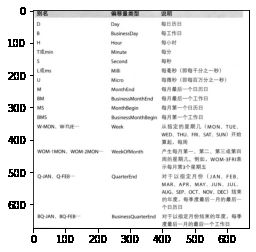
import matplotlib.pyplot as plt
from pylab import *
img = plt.imread('时间序列的基础频率2.png')
imshow(img)
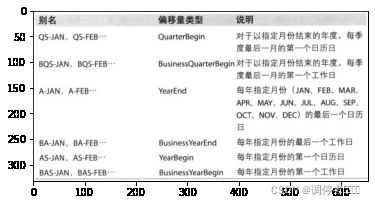
rng = pd.date_range('1/1/2012','9/1/2012',freq='WOM-3FRI')
list(rng)
[Timestamp('2012-01-20 00:00:00', freq='WOM-3FRI'),
Timestamp('2012-02-17 00:00:00', freq='WOM-3FRI'),
Timestamp('2012-03-16 00:00:00', freq='WOM-3FRI'),
Timestamp('2012-04-20 00:00:00', freq='WOM-3FRI'),
Timestamp('2012-05-18 00:00:00', freq='WOM-3FRI'),
Timestamp('2012-06-15 00:00:00', freq='WOM-3FRI'),
Timestamp('2012-07-20 00:00:00', freq='WOM-3FRI'),
Timestamp('2012-08-17 00:00:00', freq='WOM-3FRI')]
移动(超前和滞后)数据
import numpy as np
ts = Series(np.random.randn(4),
index=pd.date_range('1/1/2000',periods=4,freq='M'))
ts
2000-01-31 -0.085330
2000-02-29 0.111774
2000-03-31 1.852114
2000-04-30 -0.948230
Freq: M, dtype: float64
ts.shift(2)
2000-01-31 NaN
2000-02-29 NaN
2000-03-31 -0.085330
2000-04-30 0.111774
Freq: M, dtype: float64
ts.shift(-2)
2000-01-31 1.852114
2000-02-29 -0.948230
2000-03-31 NaN
2000-04-30 NaN
Freq: M, dtype: float64
ts/ts.shift(1)-1
2000-01-31 NaN
2000-02-29 -2.309908
2000-03-31 15.570148
2000-04-30 -1.511972
Freq: M, dtype: float64
ts.shift(2,freq='M')
2000-03-31 -0.085330
2000-04-30 0.111774
2000-05-31 1.852114
2000-06-30 -0.948230
Freq: M, dtype: float64
ts.shift(3,freq='D')
2000-02-03 -0.085330
2000-03-03 0.111774
2000-04-03 1.852114
2000-05-03 -0.948230
dtype: float64
ts.shift(1,freq='3D')
2000-02-03 -0.085330
2000-03-03 0.111774
2000-04-03 1.852114
2000-05-03 -0.948230
dtype: float64
ts.shift(1,freq='90T')
2000-01-31 01:30:00 -0.085330
2000-02-29 01:30:00 0.111774
2000-03-31 01:30:00 1.852114
2000-04-30 01:30:00 -0.948230
dtype: float64
通过偏移量对日期进行位移
from pandas.tseries.offsets import Day, MonthEnd
now = datetime.datetime(2011,11,17)
now + 3*Day()
Timestamp('2011-11-20 00:00:00')
now + MonthEnd()
Timestamp('2011-11-30 00:00:00')
now + MonthEnd(2)
Timestamp('2011-12-31 00:00:00')
offset = MonthEnd()
offset.rollforward(now)
Timestamp('2011-11-30 00:00:00')
offset.rollback(now)
Timestamp('2011-10-31 00:00:00')
ts = Series(np.random.randn(20),
index=pd.date_range('1/15/2000',periods=20,freq='4d'))
ts.groupby(offset.rollforward).mean()
2000-01-31 -0.222426
2000-02-29 -0.607156
2000-03-31 -0.313228
dtype: float64
ts.resample('M').mean()
2000-01-31 -0.222426
2000-02-29 -0.607156
2000-03-31 -0.313228
Freq: M, dtype: float64
时区处理
import pytz
pytz.common_timezones[-5:]
['US/Eastern', 'US/Hawaii', 'US/Mountain', 'US/Pacific', 'UTC']
tz = pytz.timezone('US/Eastern')
tz
本地化和转换
rng = pd.date_range('3/9/2012 9:30',periods=6,freq='D')
ts = Series(np.random.randn(len(rng)),index=rng)
print(ts.index.tz)
None
pd.date_range('3/9/2012 9:30',periods=10,freq='D',tz='UTC')
DatetimeIndex(['2012-03-09 09:30:00+00:00', '2012-03-10 09:30:00+00:00',
'2012-03-11 09:30:00+00:00', '2012-03-12 09:30:00+00:00',
'2012-03-13 09:30:00+00:00', '2012-03-14 09:30:00+00:00',
'2012-03-15 09:30:00+00:00', '2012-03-16 09:30:00+00:00',
'2012-03-17 09:30:00+00:00', '2012-03-18 09:30:00+00:00'],
dtype='datetime64[ns, UTC]', freq='D')
ts_utc = ts.tz_localize('UTC')
ts_utc
2012-03-09 09:30:00+00:00 -1.562317
2012-03-10 09:30:00+00:00 1.076885
2012-03-11 09:30:00+00:00 0.727747
2012-03-12 09:30:00+00:00 1.327910
2012-03-13 09:30:00+00:00 -0.345919
2012-03-14 09:30:00+00:00 -1.059568
Freq: D, dtype: float64
ts_utc.index
DatetimeIndex(['2012-03-09 09:30:00+00:00', '2012-03-10 09:30:00+00:00',
'2012-03-11 09:30:00+00:00', '2012-03-12 09:30:00+00:00',
'2012-03-13 09:30:00+00:00', '2012-03-14 09:30:00+00:00'],
dtype='datetime64[ns, UTC]', freq='D')
ts_utc.tz_convert('US/Eastern')
2012-03-09 04:30:00-05:00 -1.562317
2012-03-10 04:30:00-05:00 1.076885
2012-03-11 05:30:00-04:00 0.727747
2012-03-12 05:30:00-04:00 1.327910
2012-03-13 05:30:00-04:00 -0.345919
2012-03-14 05:30:00-04:00 -1.059568
Freq: D, dtype: float64
ts_eastern = ts.tz_localize('US/Eastern')
ts_eastern.tz_convert('UTC')
2012-03-09 14:30:00+00:00 -1.562317
2012-03-10 14:30:00+00:00 1.076885
2012-03-11 13:30:00+00:00 0.727747
2012-03-12 13:30:00+00:00 1.327910
2012-03-13 13:30:00+00:00 -0.345919
2012-03-14 13:30:00+00:00 -1.059568
dtype: float64
ts_eastern.tz_convert('Europe/Berlin')
2012-03-09 15:30:00+01:00 -1.562317
2012-03-10 15:30:00+01:00 1.076885
2012-03-11 14:30:00+01:00 0.727747
2012-03-12 14:30:00+01:00 1.327910
2012-03-13 14:30:00+01:00 -0.345919
2012-03-14 14:30:00+01:00 -1.059568
dtype: float64
ts.index.tz_localize('Asia/Shanghai')
DatetimeIndex(['2012-03-09 09:30:00+08:00', '2012-03-10 09:30:00+08:00',
'2012-03-11 09:30:00+08:00', '2012-03-12 09:30:00+08:00',
'2012-03-13 09:30:00+08:00', '2012-03-14 09:30:00+08:00'],
dtype='datetime64[ns, Asia/Shanghai]', freq=None)
操作时区意识型Timestamp对象
stamp = pd.Timestamp('2011-03-12 04:00')
stamp_utc = stamp.tz_localize('utc')
stamp_utc.tz_convert('US/Eastern')
Timestamp('2011-03-11 23:00:00-0500', tz='US/Eastern')
stamp_moscow = pd.Timestamp('2011-03-12 04:00',tz='Europe/Moscow')
stamp_moscow
Timestamp('2011-03-12 04:00:00+0300', tz='Europe/Moscow')
stamp_utc.value
1299902400000000000
stamp_utc.tz_convert('US/Eastern').value
1299902400000000000
from pandas.tseries.offsets import Hour
stamp = pd.Timestamp('2012-03-12 01:30',tz='US/Eastern')
stamp
Timestamp('2012-03-12 01:30:00-0400', tz='US/Eastern')
stamp + Hour()
Timestamp('2012-03-12 02:30:00-0400', tz='US/Eastern')
stamp = pd.Timestamp('2012-11-04 00:30',tz='US/Eastern')
stamp
Timestamp('2012-11-04 00:30:00-0400', tz='US/Eastern')
stamp + 2 * Hour()
Timestamp('2012-11-04 01:30:00-0500', tz='US/Eastern')
不同时区之间的运算
rng = pd.date_range('3/7/2012 9:30',periods=10,freq='B')
ts = Series(np.random.randn(len(rng)),index=rng)
ts
2012-03-07 09:30:00 0.610099
2012-03-08 09:30:00 -0.377627
2012-03-09 09:30:00 0.421953
2012-03-12 09:30:00 -0.573061
2012-03-13 09:30:00 -1.092316
2012-03-14 09:30:00 -0.816095
2012-03-15 09:30:00 0.346092
2012-03-16 09:30:00 -0.203076
2012-03-19 09:30:00 0.061797
2012-03-20 09:30:00 0.588646
Freq: B, dtype: float64
ts1 = ts[:7].tz_localize('Europe/London')
ts2 = ts1[2:].tz_convert('Europe/Moscow')
result = ts1+ts2
result.index
DatetimeIndex(['2012-03-07 09:30:00+00:00', '2012-03-08 09:30:00+00:00',
'2012-03-09 09:30:00+00:00', '2012-03-12 09:30:00+00:00',
'2012-03-13 09:30:00+00:00', '2012-03-14 09:30:00+00:00',
'2012-03-15 09:30:00+00:00'],
dtype='datetime64[ns, UTC]', freq=None)
时期及其算术运算
p = pd.Period(2007,freq='A-DEC')
p
Period('2007', 'A-DEC')
p + 5
Period('2012', 'A-DEC')
p - 2
Period('2005', 'A-DEC')
pd.Period('2014',freq='A-DEC') - p
<7 * YearEnds: month=12>
rng = pd.period_range('1/1/2000','6/30/2000',freq='M')
rng
PeriodIndex(['2000-01', '2000-02', '2000-03', '2000-04', '2000-05', '2000-06'], dtype='period[M]')
Series(np.random.randn(6),index=rng)
2000-01 -0.381308
2000-02 -0.433367
2000-03 -1.091356
2000-04 0.276813
2000-05 0.284625
2000-06 0.074151
Freq: M, dtype: float64
values = ['2001Q3','2002Q2','2003Q1']
index = pd.PeriodIndex(values,freq='Q-DEC')
index
PeriodIndex(['2001Q3', '2002Q2', '2003Q1'], dtype='period[Q-DEC]')
时期的频率转换
p = pd.Period('2007',freq='A-DEC')
p.asfreq('M',how='start')
Period('2007-01', 'M')
p.asfreq('M',how='end')
Period('2007-12', 'M')
p = pd.Period('2007',freq='A-JUN')
p.asfreq('M','start')
Period('2006-07', 'M')
p.asfreq('M','end')
Period('2007-06', 'M')
p = pd.Period('2007-08','M')
p.asfreq('A-JUN')
Period('2008', 'A-JUN')
rng = pd.period_range('2006','2009',freq='A-DEC')
ts = Series(np.random.randn(len(rng)),index=rng)
ts
2006 1.185920
2007 -1.529096
2008 1.232203
2009 0.161538
Freq: A-DEC, dtype: float64
ts.asfreq('M',how='start')
2006-01 1.185920
2007-01 -1.529096
2008-01 1.232203
2009-01 0.161538
Freq: M, dtype: float64
ts.asfreq('B',how='end')
2006-12-29 1.185920
2007-12-31 -1.529096
2008-12-31 1.232203
2009-12-31 0.161538
Freq: B, dtype: float64
按季度计算的时期频率
p = pd.Period('2012Q4',freq='Q-JAN')
p
Period('2012Q4', 'Q-JAN')
p.asfreq('D','start')
Period('2011-11-01', 'D')
p.asfreq('D','end')
Period('2012-01-31', 'D')
p4pm = (p.asfreq('B','e')-1).asfreq('T','s')+16*60
p4pm
Period('2012-01-30 16:00', 'T')
p4pm.to_timestamp()
Timestamp('2012-01-30 16:00:00')
rng = pd.period_range('2011Q3','2012Q4',freq='Q-JAN')
ts = Series(np.arange(len(rng)),index=rng)
ts
2011Q3 0
2011Q4 1
2012Q1 2
2012Q2 3
2012Q3 4
2012Q4 5
Freq: Q-JAN, dtype: int32
new_rng = (rng.asfreq('B','e')-1).asfreq('T','s')+16*60
ts.index = new_rng.to_timestamp()
ts
2010-10-28 16:00:00 0
2011-01-28 16:00:00 1
2011-04-28 16:00:00 2
2011-07-28 16:00:00 3
2011-10-28 16:00:00 4
2012-01-30 16:00:00 5
dtype: int32
将Timestamp转换为Period(及其反向过程)
rng = pd.date_range('1/1/2000',periods=3,freq='M')
ts = Series(randn(3),index=rng)
pts = ts.to_period()
ts
2000-01-31 0.827634
2000-02-29 0.238047
2000-03-31 -0.154483
Freq: M, dtype: float64
pts
2000-01 0.827634
2000-02 0.238047
2000-03 -0.154483
Freq: M, dtype: float64
rng = pd.date_range('1/29/2000',periods=6,freq='D')
ts2 = Series(randn(6),index=rng)
ts2.to_period('M')
2000-01 -1.799402
2000-01 -0.281554
2000-01 -0.979846
2000-02 -1.499961
2000-02 0.192467
2000-02 0.126386
Freq: M, dtype: float64
pts = ts.to_period()
pts
2000-01 0.827634
2000-02 0.238047
2000-03 -0.154483
Freq: M, dtype: float64
pts.to_timestamp(how='end')
2000-01-31 23:59:59.999999999 0.827634
2000-02-29 23:59:59.999999999 0.238047
2000-03-31 23:59:59.999999999 -0.154483
dtype: float64
通过数组创建PeriodIndex
data = pd.read_csv("E:\python_study_files\python\pydata-book-2nd-edition\examples\macrodata.csv")
data.year
0 1959.0
1 1959.0
2 1959.0
3 1959.0
4 1960.0
...
198 2008.0
199 2008.0
200 2009.0
201 2009.0
202 2009.0
Name: year, Length: 203, dtype: float64
data.quarter
0 1.0
1 2.0
2 3.0
3 4.0
4 1.0
...
198 3.0
199 4.0
200 1.0
201 2.0
202 3.0
Name: quarter, Length: 203, dtype: float64
index = pd.PeriodIndex(year=data.year,quarter=data.quarter,freq='Q-DEC')
index
PeriodIndex(['1959Q1', '1959Q2', '1959Q3', '1959Q4', '1960Q1', '1960Q2',
'1960Q3', '1960Q4', '1961Q1', '1961Q2',
...
'2007Q2', '2007Q3', '2007Q4', '2008Q1', '2008Q2', '2008Q3',
'2008Q4', '2009Q1', '2009Q2', '2009Q3'],
dtype='period[Q-DEC]', length=203)
data.index = index
data.infl
1959Q1 0.00
1959Q2 2.34
1959Q3 2.74
1959Q4 0.27
1960Q1 2.31
...
2008Q3 -3.16
2008Q4 -8.79
2009Q1 0.94
2009Q2 3.37
2009Q3 3.56
Freq: Q-DEC, Name: infl, Length: 203, dtype: float64
重采样及频率转换
将高频率数据聚合到低频率称为降采样,将低频率数据转换到高频率则称为升采样。
rng = pd.date_range('1/1/2000',periods=100,freq='D')
ts = Series(randn(len(rng)),index=rng)
ts.resample('M').mean()
2000-01-31 0.070790
2000-02-29 0.026944
2000-03-31 -0.011548
2000-04-30 0.078033
Freq: M, dtype: float64
ts.resample('M',kind='period').mean()
2000-01 0.070790
2000-02 0.026944
2000-03 -0.011548
2000-04 0.078033
Freq: M, dtype: float64
import matplotlib.pyplot as plt
from pylab import *
img = plt.imread('resample方法的参数.png')
imshow(img)
[外链图片转存失败,源站可能有防盗链机制,建议将图片保存下来直接上传(img-Amf01oEA-1646554497891)(output_150_1.png)]
降采样
rng = pd.date_range('1/1/2000',periods=12,freq='T')
ts = Series(np.arange(12),index=rng)
ts
2000-01-01 00:00:00 0
2000-01-01 00:01:00 1
2000-01-01 00:02:00 2
2000-01-01 00:03:00 3
2000-01-01 00:04:00 4
2000-01-01 00:05:00 5
2000-01-01 00:06:00 6
2000-01-01 00:07:00 7
2000-01-01 00:08:00 8
2000-01-01 00:09:00 9
2000-01-01 00:10:00 10
2000-01-01 00:11:00 11
Freq: T, dtype: int32
ts.resample('5min').sum()
2000-01-01 00:00:00 10
2000-01-01 00:05:00 35
2000-01-01 00:10:00 21
Freq: 5T, dtype: int32
ts.resample('5min',closed='right').sum()
1999-12-31 23:55:00 0
2000-01-01 00:00:00 15
2000-01-01 00:05:00 40
2000-01-01 00:10:00 11
Freq: 5T, dtype: int32
ts.resample('5min',closed='left',label='left').sum()
2000-01-01 00:00:00 10
2000-01-01 00:05:00 35
2000-01-01 00:10:00 21
Freq: 5T, dtype: int32
ts.resample('5min',loffset='-1s').sum()
C:\windows FutureWarning: 'loffset' in .resample() and in Grouper() is deprecated.
>>> df.resample(freq="3s", loffset="8H")
becomes:
>>> from pandas.tseries.frequencies import to_offset
>>> df = df.resample(freq="3s").mean()
>>> df.index = df.index.to_timestamp() + to_offset("8H")
ts.resample('5min',loffset='-1s').sum()
1999-12-31 23:59:59 10
2000-01-01 00:04:59 35
2000-01-01 00:09:59 21
Freq: 5T, dtype: int32
OHLC重采样
ts.resample('5min').ohlc()
|
open |
high |
low |
close |
| 2000-01-01 00:00:00 |
0 |
4 |
0 |
4 |
| 2000-01-01 00:05:00 |
5 |
9 |
5 |
9 |
| 2000-01-01 00:10:00 |
10 |
11 |
10 |
11 |
通过groupby进行重采样
rng = pd.date_range('1/1/2000',periods=100,freq='D')
ts = Series(np.arange(100),index=rng)
ts.groupby(lambda x: x.month).mean()
1 15.0
2 45.0
3 75.0
4 95.0
dtype: float64
ts.groupby(lambda x: x.weekday).mean()
0 47.5
1 48.5
2 49.5
3 50.5
4 51.5
5 49.0
6 50.0
dtype: float64
升采样和插值
frame = DataFrame(np.random.randn(2,4),
index=pd.date_range('1/1/2000',periods=2,freq='W-WED'),
columns=['Colorado','Texas','New York','Ohio'])
frame[:5]
|
Colorado |
Texas |
New York |
Ohio |
| 2000-01-05 |
-0.639248 |
0.966629 |
1.353138 |
-0.141245 |
| 2000-01-12 |
-0.202733 |
2.769799 |
-0.172722 |
1.090545 |
df_daily = frame.resample('D')
df_daily
frame.resample('D').ffill()
|
Colorado |
Texas |
New York |
Ohio |
| 2000-01-05 |
-0.639248 |
0.966629 |
1.353138 |
-0.141245 |
| 2000-01-06 |
-0.639248 |
0.966629 |
1.353138 |
-0.141245 |
| 2000-01-07 |
-0.639248 |
0.966629 |
1.353138 |
-0.141245 |
| 2000-01-08 |
-0.639248 |
0.966629 |
1.353138 |
-0.141245 |
| 2000-01-09 |
-0.639248 |
0.966629 |
1.353138 |
-0.141245 |
| 2000-01-10 |
-0.639248 |
0.966629 |
1.353138 |
-0.141245 |
| 2000-01-11 |
-0.639248 |
0.966629 |
1.353138 |
-0.141245 |
| 2000-01-12 |
-0.202733 |
2.769799 |
-0.172722 |
1.090545 |
frame.resample('D').ffill(limit=2)
|
Colorado |
Texas |
New York |
Ohio |
| 2000-01-05 |
-0.639248 |
0.966629 |
1.353138 |
-0.141245 |
| 2000-01-06 |
-0.639248 |
0.966629 |
1.353138 |
-0.141245 |
| 2000-01-07 |
-0.639248 |
0.966629 |
1.353138 |
-0.141245 |
| 2000-01-08 |
NaN |
NaN |
NaN |
NaN |
| 2000-01-09 |
NaN |
NaN |
NaN |
NaN |
| 2000-01-10 |
NaN |
NaN |
NaN |
NaN |
| 2000-01-11 |
NaN |
NaN |
NaN |
NaN |
| 2000-01-12 |
-0.202733 |
2.769799 |
-0.172722 |
1.090545 |
frame.resample('W-THU').ffill()
|
Colorado |
Texas |
New York |
Ohio |
| 2000-01-06 |
-0.639248 |
0.966629 |
1.353138 |
-0.141245 |
| 2000-01-13 |
-0.202733 |
2.769799 |
-0.172722 |
1.090545 |
通过时期进行重采样
frame = DataFrame(np.random.randn(24,4),
index=pd.period_range('1-2000','12-2001',freq='M'),
columns=['Colorado','Texas','New York','Ohio'])
frame[:5]
|
Colorado |
Texas |
New York |
Ohio |
| 2000-01 |
-0.111358 |
-0.647902 |
-1.546984 |
-0.723733 |
| 2000-02 |
0.080523 |
-0.957168 |
-0.032819 |
-0.142153 |
| 2000-03 |
-0.357317 |
0.714370 |
0.381672 |
-1.212166 |
| 2000-04 |
-2.072597 |
-1.275430 |
-0.972187 |
0.395826 |
| 2000-05 |
0.204685 |
0.403605 |
-0.206892 |
-0.623941 |
annual_frame = frame.resample('A-DEC').mean()
annual_frame
|
Colorado |
Texas |
New York |
Ohio |
| 2000 |
-0.094581 |
0.172699 |
-0.01049 |
-0.184761 |
| 2001 |
-0.209692 |
0.172219 |
-0.16941 |
-0.244421 |
annual_frame.resample('Q-DEC').ffill()
|
Colorado |
Texas |
New York |
Ohio |
| 2000Q1 |
-0.094581 |
0.172699 |
-0.01049 |
-0.184761 |
| 2000Q2 |
-0.094581 |
0.172699 |
-0.01049 |
-0.184761 |
| 2000Q3 |
-0.094581 |
0.172699 |
-0.01049 |
-0.184761 |
| 2000Q4 |
-0.094581 |
0.172699 |
-0.01049 |
-0.184761 |
| 2001Q1 |
-0.209692 |
0.172219 |
-0.16941 |
-0.244421 |
| 2001Q2 |
-0.209692 |
0.172219 |
-0.16941 |
-0.244421 |
| 2001Q3 |
-0.209692 |
0.172219 |
-0.16941 |
-0.244421 |
| 2001Q4 |
-0.209692 |
0.172219 |
-0.16941 |
-0.244421 |
annual_frame.resample('Q-DEC',convention='start').ffill()
|
Colorado |
Texas |
New York |
Ohio |
| 2000Q1 |
-0.094581 |
0.172699 |
-0.01049 |
-0.184761 |
| 2000Q2 |
-0.094581 |
0.172699 |
-0.01049 |
-0.184761 |
| 2000Q3 |
-0.094581 |
0.172699 |
-0.01049 |
-0.184761 |
| 2000Q4 |
-0.094581 |
0.172699 |
-0.01049 |
-0.184761 |
| 2001Q1 |
-0.209692 |
0.172219 |
-0.16941 |
-0.244421 |
| 2001Q2 |
-0.209692 |
0.172219 |
-0.16941 |
-0.244421 |
| 2001Q3 |
-0.209692 |
0.172219 |
-0.16941 |
-0.244421 |
| 2001Q4 |
-0.209692 |
0.172219 |
-0.16941 |
-0.244421 |
annual_frame.resample('Q-MAR').ffill()
|
Colorado |
Texas |
New York |
Ohio |
| 2000Q4 |
-0.094581 |
0.172699 |
-0.01049 |
-0.184761 |
| 2001Q1 |
-0.094581 |
0.172699 |
-0.01049 |
-0.184761 |
| 2001Q2 |
-0.094581 |
0.172699 |
-0.01049 |
-0.184761 |
| 2001Q3 |
-0.094581 |
0.172699 |
-0.01049 |
-0.184761 |
| 2001Q4 |
-0.209692 |
0.172219 |
-0.16941 |
-0.244421 |
| 2002Q1 |
-0.209692 |
0.172219 |
-0.16941 |
-0.244421 |
| 2002Q2 |
-0.209692 |
0.172219 |
-0.16941 |
-0.244421 |
| 2002Q3 |
-0.209692 |
0.172219 |
-0.16941 |
-0.244421 |
时间序列绘图
close_px_all = pd.read_csv("E:\python_study_files\python\pydata-book-2nd-edition\examples\stock_px.csv",parse_dates=True,index_col=0)
close_px = close_px_all[['AAPL','MSFT','XOM']]
close_px = close_px.resample('B').ffill()
close_px
|
AAPL |
MSFT |
XOM |
| 1990-02-01 |
7.86 |
0.51 |
6.12 |
| 1990-02-02 |
8.00 |
0.51 |
6.24 |
| 1990-02-05 |
8.18 |
0.51 |
6.25 |
| 1990-02-06 |
8.12 |
0.51 |
6.23 |
| 1990-02-07 |
7.77 |
0.51 |
6.33 |
| ... |
... |
... |
... |
| 2011-10-10 |
388.81 |
26.94 |
76.28 |
| 2011-10-11 |
400.29 |
27.00 |
76.27 |
| 2011-10-12 |
402.19 |
26.96 |
77.16 |
| 2011-10-13 |
408.43 |
27.18 |
76.37 |
| 2011-10-14 |
422.00 |
27.27 |
78.11 |
5662 rows × 3 columns
close_px['AAPL'].plot()
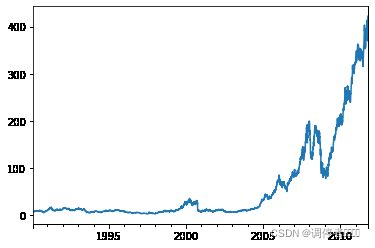
close_px.loc['2009'].plot()
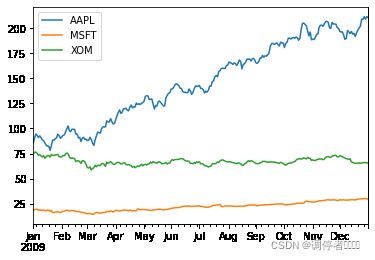
close_px['AAPL'].loc['01-2011':'03-2011'].plot()

appl_q = close_px['AAPL'].resample('Q-DEC').ffill()
appl_q.loc['2009':].plot()
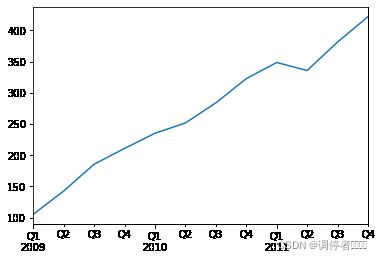
移动窗口函数
close_px.AAPL.plot()
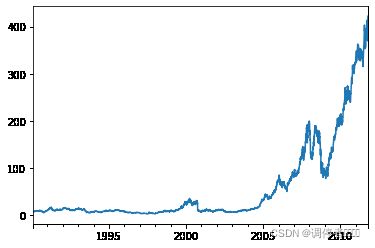
close_px.AAPL.rolling(window=250).mean().plot()
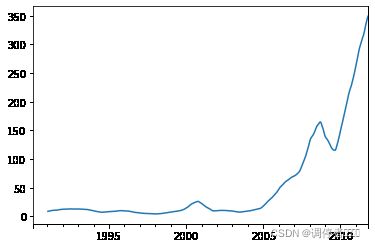
appl_std250 = close_px.AAPL.rolling(window=250,min_periods=10).std()
appl_std250[5:12]
1990-02-08 NaN
1990-02-09 NaN
1990-02-12 NaN
1990-02-13 NaN
1990-02-14 0.148189
1990-02-15 0.141003
1990-02-16 0.135454
Freq: B, Name: AAPL, dtype: float64
appl_std250.plot()
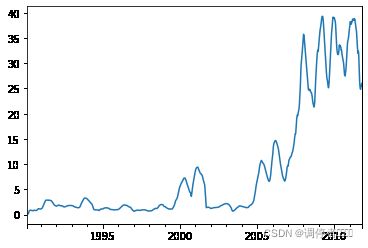
expanding_mean = lambda x: x.rolling(window=len(x),min_periods=1).mean()
close_px.rolling(60).mean().plot(logy=True)
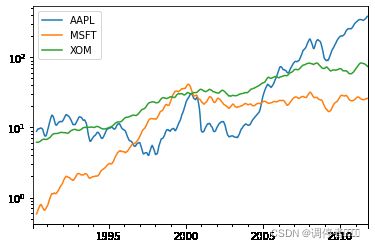
import matplotlib.pyplot as plt
from pylab import *
img = plt.imread('移动窗口和指数加权函数.png')
imshow(img)
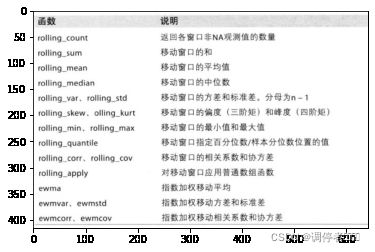
指数加权函数
fig, axes = plt.subplots(nrows=2,ncols=1,sharex=True,sharey=True,figsize=(12,7))
aapl_px = close_px.AAPL['2005':'2009']
ma60 = aapl_px.rolling(window=60,min_periods=50).mean()
ewma60 = pd.DataFrame.ewm(aapl_px,span=60)
aapl_px.plot(style='k-',ax=axes[0])
ma60.plot(style='k--',ax=axes[0])
aapl_px.plot(style='k--',ax=axes[1])
ewma60.plot(style='k--',ax=axes[1])
axes[0].set_title('Simple MA')
axes[1].set_title('Exponentially-weighted MA')
---------------------------------------------------------------------------
AttributeError Traceback (most recent call last)
C:\window in
8 ma60.plot(style='k--',ax=axes[0])
9 aapl_px.plot(style='k--',ax=axes[1])
---> 10 ewma60.plot(style='k--',ax=axes[1])
11 axes[0].set_title('Simple MA')
12 axes[1].set_title('Exponentially-weighted MA')
AttributeError: 'ExponentialMovingWindow' object has no attribute 'plot'
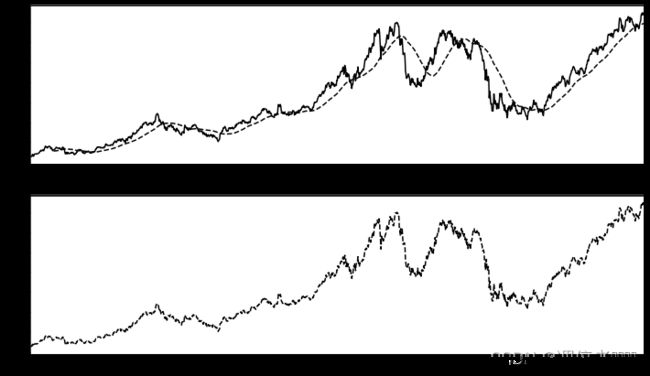
二元移动窗口函数
spx_px = close_px_all['SPX']
spx_rets = spx_px/spx_px.shift(1)-1
returns = close_px.pct_change()
corr = returns.AAPL.rolling(window=125,min_periods=100).corr(spx_rets)
corr.plot()
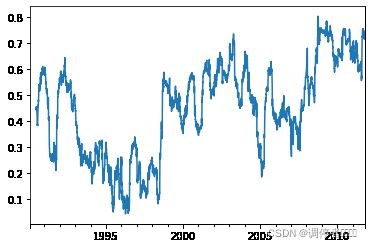
corr = returns.rolling(window=125,min_periods=100).corr(spx_rets)
corr.plot()
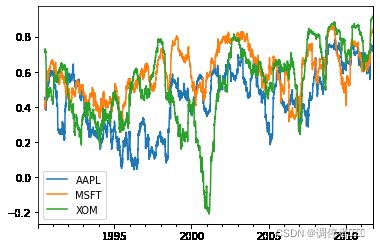
用户定义的移动窗口函数
from scipy.stats import percentileofscore
score_at_2percent = lambda x: percentileofscore(x,0.02)
result = returns.AAPL.rolling(window=250).apply(score_at_2percent)
result.plot()
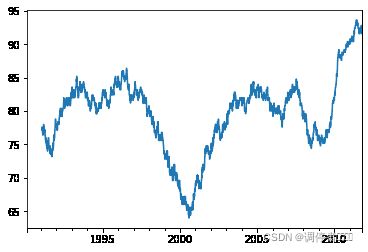
性能和内存使用方面的注意事项
rng = pd.date_range('1/1/2000',periods=10000000,freq='10ms')
ts = Series(np.random.randn(len(rng)),index=rng)
ts
2000-01-01 00:00:00.000 -2.158081
2000-01-01 00:00:00.010 -0.800653
2000-01-01 00:00:00.020 -1.063636
2000-01-01 00:00:00.030 -0.350992
2000-01-01 00:00:00.040 0.025731
...
2000-01-02 03:46:39.950 1.064119
2000-01-02 03:46:39.960 -1.168419
2000-01-02 03:46:39.970 0.165532
2000-01-02 03:46:39.980 -0.335836
2000-01-02 03:46:39.990 0.906393
Freq: 10L, Length: 10000000, dtype: float64
ts.resample('15min').ohlc()
|
open |
high |
low |
close |
| 2000-01-01 00:00:00 |
-2.158081 |
4.707701 |
-4.575291 |
-0.681948 |
| 2000-01-01 00:15:00 |
-1.153593 |
4.948694 |
-4.179428 |
-0.846462 |
| 2000-01-01 00:30:00 |
0.264933 |
3.978436 |
-4.369072 |
-1.591544 |
| 2000-01-01 00:45:00 |
-0.733233 |
4.702323 |
-4.718692 |
-0.031456 |
| 2000-01-01 01:00:00 |
0.409060 |
4.495952 |
-4.611355 |
-0.462664 |
| ... |
... |
... |
... |
... |
| 2000-01-02 02:45:00 |
0.543960 |
4.395054 |
-4.944563 |
-0.389855 |
| 2000-01-02 03:00:00 |
-2.653642 |
3.921464 |
-4.256564 |
-0.513813 |
| 2000-01-02 03:15:00 |
-0.429338 |
4.326163 |
-4.141456 |
-0.542056 |
| 2000-01-02 03:30:00 |
-0.739633 |
4.639564 |
-4.794910 |
0.619659 |
| 2000-01-02 03:45:00 |
-0.787038 |
4.072322 |
-3.949441 |
0.906393 |
112 rows × 4 columns
%timeit ts.resample('15min').ohlc()
109 ms ± 3.1 ms per loop (mean ± std. dev. of 7 runs, 10 loops each)
%timeit ts.resample('15s').ohlc()
113 ms ± 2.48 ms per loop (mean ± std. dev. of 7 runs, 10 loops each)

















